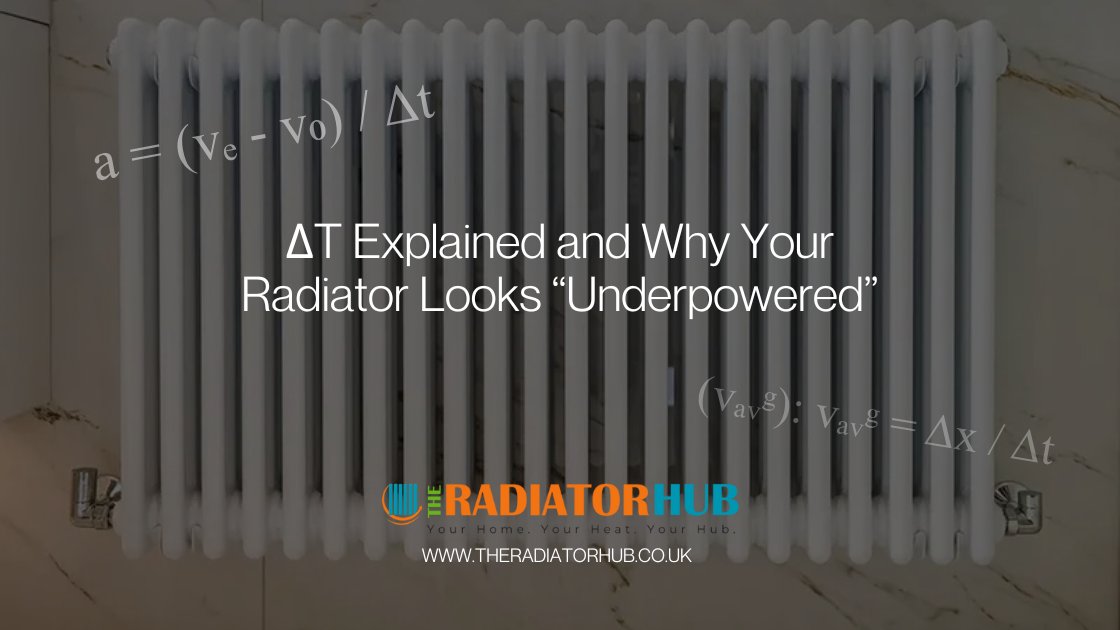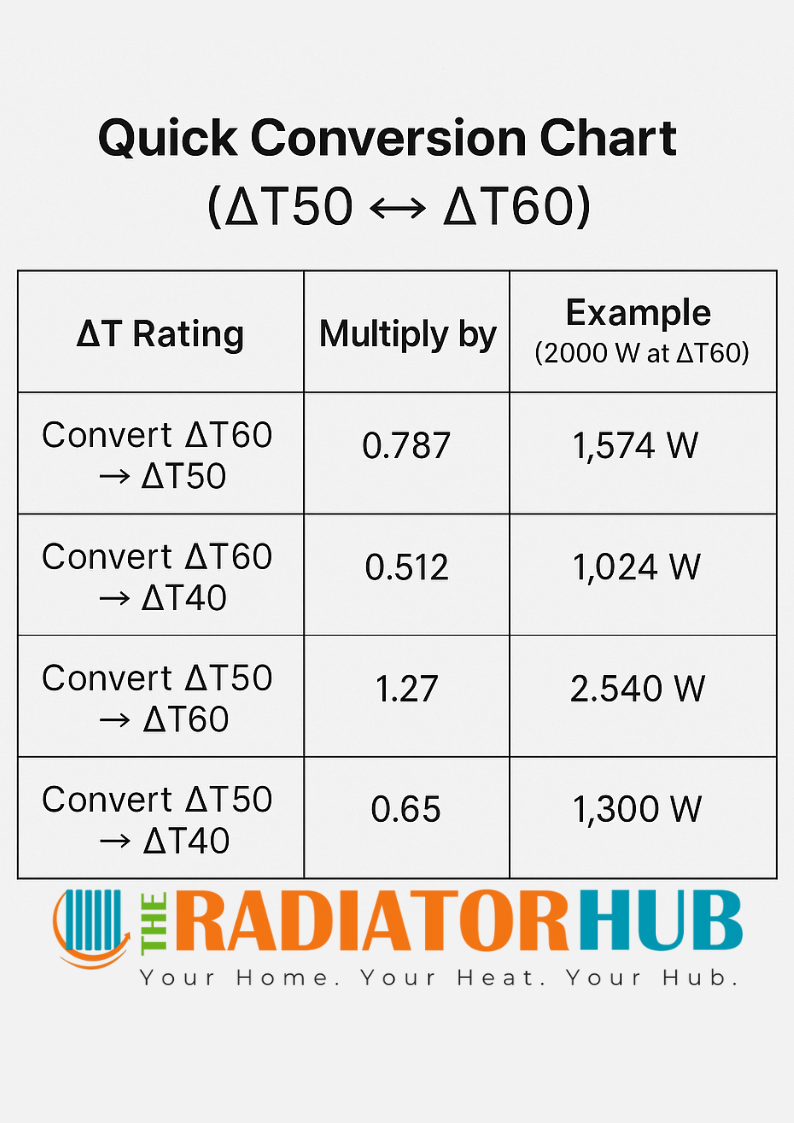Blog
ΔT Explained and Why Your Radiator Looks “Underpowered”

ΔT Explained and Why Your Radiator Looks “Underpowered”
Ever compared two identical looking radiators online only to find totally different heat outputs? One might claim 5,000 BTU, another 6,300 BTU. That’s not a mistake, it’s all about ΔT (Delta T), the temperature difference used to measure radiator heat performance.
Understanding ΔT is essential if you want an efficient, correctly sized radiator that keeps every room comfortable. This short guide explains what ΔT means, why the UK uses ΔT50, and how to compare radiator outputs properly.
What Does ΔT (Delta T) Mean in Radiators?
ΔT (pronounced “Delta T”) simply measures the difference between the average water temperature inside your radiator and the air temperature in your room.
It’s calculated using the formula:
ΔT=(Flow Temperature+Return Temperature)2−Room Temperature\Delta T = \frac{(\text{Flow Temperature} + \text{Return Temperature})}{2} - \text{Room Temperature}ΔT=2(Flow Temperature+Return Temperature)−Room Temperature
Example:
If your system runs at 75°C flow / 65°C return / 20°C room,
(75+65)/2−20=ΔT50(75 + 65) / 2 - 20 = \Delta T50(75+65)/2−20=ΔT50
That ΔT figure becomes the benchmark for how much heat (in watts or BTUs) your radiator can emit.
The Crucial Link to BTU and Wattage
The ΔT figure is the backbone of every radiator’s heat output rating. When you use a radiator BTU calculator, that final BTU figure must match a radiator’s heat output rated at the same ΔT value, usually ΔT50 in the UK.
If you accidentally compare BTUs from a ΔT60 radiator against a ΔT50 calculator result, your chosen radiator will likely be undersized and leave the room cooler than expected.
Why the UK Uses ΔT50 and Europe Often Uses ΔT60
In the UK, modern radiator ratings are based on ΔT50, following the EN442 testing standard used across the heating industry.
However, many European suppliers and some UK websites importing EU data, list radiators at ΔT60, which assumes hotter water temperatures. The result is that radiators tested at ΔT60 look more powerful on paper, even though they emit less heat in a UK home running on ΔT50.
| Test Temperature | Flow / Return / Room | ΔT | Typical System |
|---|---|---|---|
| EN442 UK Standard | 75 / 65 / 20 °C | 50 °C | Condensing boilers (UK standard) |
| EU Listing Example | 80 / 60 / 20 °C | 60 °C | Older boilers / high-flow systems |
How to Compare Radiator Outputs Across ΔT Ratings
To make fair comparisons, always ensure you’re looking at the same ΔT rating.
If one retailer lists outputs at ΔT60 and another at ΔT50, you can use this simple conversion:
From ΔT60 → ΔT50: multiply by 0.787
From ΔT50 → ΔT60: divide by 0.787
Example:
A 6,300 BTU radiator at ΔT60 produces roughly 4,960 BTU at ΔT50, the true performance under typical UK conditions.
Real Example: Same Radiator at ΔT50 vs ΔT60
| Model | Output @ ΔT60 | Output @ ΔT50 | Room Suitability |
|---|---|---|---|
| Reina Dimaro Radiator 1760×620 | 3,648 BTU | 2,850 BTU | Medium to large living room |
| TRH Stafford Double Vertical Radiator 1800×407 White | 4,359 BTU (approx. ΔT60) | 3,432 BTU | Lounge or hallway |
| TRH Sheringham Double Horizontal Radiator 600×612 Anthracite | 2,535 BTU (approx. ΔT60) | 1,996 BTU | Bedroom or study |
Note how a high-efficiency ΔT50 output is significantly lower than the ΔT60 rating, a difference that can easily result in an undersized radiator if ΔT values aren’t matched correctly.
What ΔT Means for Your Room Heat Output
A radiator running on a condensing boiler (ΔT50) emits about 20-25% less heat than it would under ΔT60 conditions. That’s why checking ΔT before you buy is so important.
If you’re upgrading to a heat pump or a low temperature system, your ΔT may be closer to 35-40, so radiators must be sized larger to compensate.
Quick Conversion Chart (ΔT50 ↔ ΔT60)
| ΔT Rating | Multiply by | Example (2000 W at ΔT60) |
|---|---|---|
| Convert ΔT60 → ΔT50 | 0.787 | 1,574 W |
| Convert ΔT60 → ΔT40 | 0.512 | 1,024 W |
| Convert ΔT50 → ΔT60 | 1.27 | 2,540 W |
| Convert ΔT50 → ΔT40 | 0.65 | 1,300 W |

Choosing the Right Radiator for Your Heating System
Check your flow temperatures.
Condensing boiler: 75/65 °C → ΔT50
Heat pump: 55/45 °C → ΔT35–40
Use a radiator BTU calculator to estimate each room’s heat requirement.
Match your chosen radiator’s output to that BTU at the same ΔT value.
Explore by type - Designer Radiators, Vertical Radiators, or Towel Rails to find the best fit.
Final Thoughts, Efficiency, Accuracy & Comfort
Knowing the difference between ΔT50 and ΔT60 helps you buy the right radiator the first time. It also ensures your heating system runs efficiently, comfortably, and economically.
At The Radiator Hub, every radiator is tested and listed to the UK’s ΔT50 EN442 standard so you can compare outputs with confidence.
👉 Ready to upgrade? Discover our full collection of High-Efficiency Designer Radiators.
FAQs
Q1 What does ΔT mean on a radiator?
A1 ΔT (Delta T) is the temperature difference between the average water temperature inside your radiator and the room air temperature.
Q2 What is the UK standard ΔT for radiators?
A2 The UK standard is ΔT50, meaning radiator outputs are measured using a 50°C temperature difference.
Q3 How do I convert ΔT60 to ΔT50?
A3 Multiply the ΔT60 wattage by 0.787 to get the equivalent ΔT50 output.
Q4 Why is my radiator’s BTU lower than another website’s?
A4 Some retailers list at ΔT60, which gives a higher output. Always compare using the same ΔT standard.
Q5 Does ΔT affect energy efficiency?
A5 Not directly, the radiator design stays the same but running lower ΔT systems (50 °C or below) is more efficient for condensing boilers and heat pumps.



